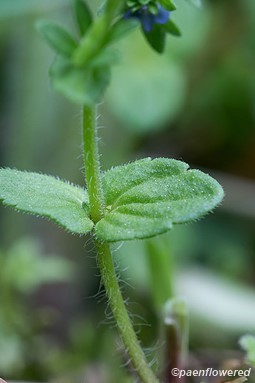Veronica arvensis
Veronica arvensis common speedwell
This is one of 20 speedwell species that grows in the United States. This one is native to Europe, Asia and North Africa but was brought early to North America by European settlers. It is a small and inconspicuous plant and easily missed by the average person. It can grow 1-6 inches long, but is a low creeping plant, sometimes forming mats up to 3 inches in diameter.
The leaves are oval or triangular and toothed. The lower ones have short petioles, while the upper ones are sessile. The leaves average about 1.5 to 2 cm long at maximum growth. Both the leaves and stem are hairy.
The tiny flowers are only 1/8 inch in diameter and are blue-violet in color with some lines radiating out from the center. There are four petals, with the lower one smaller than the others. The sepals are a bit larger than the petals. The individual blooms open at midday for a short period and then the petals fall off and it goes to seed.
Small bees and flies tend to be the major pollinator of this plant. Like most invasive species, the Corm Speedwell grows best in disturbed ground and is often found in lawns, along roadsides, and in fields and gardens. In places where it interferes with the growth of other plants it is considered a noxious weed. It is a winter annual plant that blooms in the spring and then dies back. The seeds germinate in the fall to establish the next generation of plants. The root system is shallow and fibrous.
Habitat & Range
Frequent in disturbed soils of woods, roadside banks, meadows, and lawns.
Present throughout the state.
| EMP: | UPL |
|---|---|
| NCNE: | FACU |
Phenology
Flowers April to September.









.jpg?v=637828013470000000)




Comments
Have you spotted this plant in your area? We'd love to hear about your experience! Share your comments or questions about the plant below. Comments are moderated before posting.